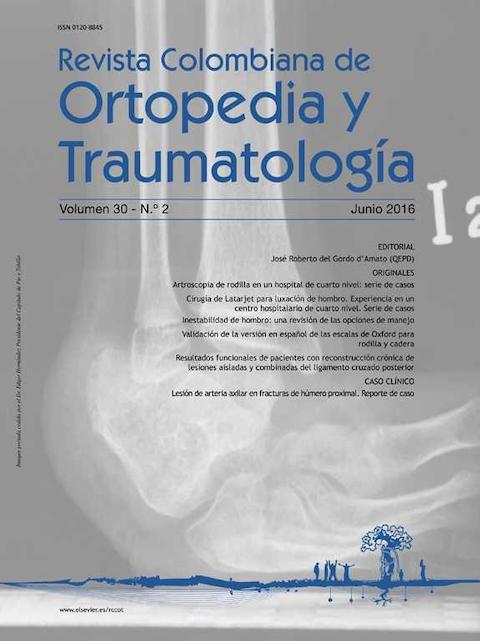Shoulder instability: Management current concepts
DOI:
https://doi.org/10.1016/j.rccot.2016.07.007Keywords:
instability, joint, shoulder, management, treatment, arthroscopic, surgeryAbstract
It is known that shoulder is the structure in the body with the highest range of motion, property that ironically makes it more susceptible to dislocations, which is a major challenge for orthopedists. Shoulder dislocation has an incidence of 11.2/100,000 people per year, with a prevalence of 2% in general population. Traumatic dislocation is the main cause of first episode of anterior shoulder dislocation in 95% of the patients, while the posterior dislocation is 2-4% of all gleno-humeral dislocations.
There are data reporting the incidence in the American population between 8.2 and 23.9/100,000 people per year. The distribution of shoulder dislocation has been presented in a particular way with population peaks in the second and sixth decades of life. There are two ways to manage this kind of situations, conservatively or surgically, for surgery there are two management options: open or closed (arthroscopic). With regard to conservative management the traditional technique is immobilization with sling or brace in a neutral position for 2-4 weeks after reduction, when we are in the presence of a dislocation that requires rapid start of movements at rest as well as assisted in order to rehabilitate the patient. Currently there are several tools to assess the quality of life following any shoulder procedure. It is worth mentioning WOSI scale which specifically evaluates the quality of life in patients with a history of shoulder instability.
Evidence Level: IV.
Downloads
References
Iqbal S, Jacobs U, Akhtar A, Macfarlane R, Waseem M. A history of shoulder surgery. Open Orthop J. 2013;6:305-9. https://doi.org/10.2174/1874325001307010305
Pope EJ, Ward JP, Rokito AS. Anterior shoulder instability - a history of arthroscopic treatment. Bull NYU Hosp Jt Dis. 2011;69:44-9.
Sofu H, Gürsu S, Koc¸kara N, Oner A, Issın A, Camurcu Y. Recurrent anterior shoulder instability: Review of the literature and current concepts. World J Clin Cases. 2014;2:676-82. https://doi.org/10.12998/wjcc.v2.i11.676
Taş M, Canbora MK, Köse Ö, E˘gerci ÖF, Gem M. Demographic and clinical characteristics of traumatic shoulder dislocations in an urban city of Turkey: a retrospective analysis of 208 cases. Acta Orthop Traumatol Turc. 2013;47:147-52. https://doi.org/10.3944/AOTT.2013.3090
Arliani GG, Astur D, da C, Cohen C, Ejnisman B, Andreoli CV, Pochini AC, et al. Surgical versus nonsurgical treatment in first traumatic anterior dislocation of the shoulder in athletes. Open Access J Sports Med. 2011;2:19-24. https://doi.org/10.2147/OAJSM.S17378
McAdams TR, Fredericson M, Vogelsong M, Gold G. New developments in magnetic resonance imaging techniques for shoulder instability in athletes. Open Access J Sports Med. 2010;1:137-42. https://doi.org/10.2147/OAJSM.S9058
Magarey M, Jones M. Clinical diagnosis and management of minor shoulder instability. Aust J Physiother. 1992;38:269-80. https://doi.org/10.1016/S0004-9514(14)60570-5
Paxton ES, Dodson CC, Lazarus MD. Shoulder instability in older patients. Orthop Clin North Am. 2014;45:377-85. https://doi.org/10.1016/j.ocl.2014.04.002
Cadet ER. Evaluation of glenohumeral instability. Orthop Clin North Am. 2010;41:287-95. https://doi.org/10.1016/j.ocl.2010.02.005
Milewski MD, Nissen CW. Pediatric and adolescent shoulder instability. Clin Sports Med. 2013;32:761-79. https://doi.org/10.1016/j.csm.2013.07.010
Farrar NG, Malal JJG, Fischer J, Waseem M. An overview of shoulder instability and its management. Open Orthop J. 2013;7:338-46. https://doi.org/10.2174/1874325001307010338
Dumont GD, Russell RD, Robertson WJ. Anterior shoulder instability: a review of pathoanatomy, diagnosis and treatment. Curr Rev Musculoskelet Med. 2011;4:200-7. https://doi.org/10.1007/s12178-011-9092-9
Rouleau DM, Hebert-Davies J. Incidence of associated injury in posterior shoulder dislocation: systematic review of the literature. J Orthop Trauma. 2012;26:246-51. https://doi.org/10.1097/BOT.0b013e3182243909
Rouleau DM, Hebert-Davies J, Robinson CM. Acute traumatic posterior shoulder dislocation. J Am Acad Orthop Surg. 2014;22:145-52. https://doi.org/10.5435/JAAOS-22-03-145
Boileau P, Fourati E, Bicknell R. Neer modification of open Bankart procedure: what are the rates of recurrent instability, functional outcome, and arthritis? Clin Orthop. 2012;470:2554-60. https://doi.org/10.1007/s11999-012-2296-5
Brophy RH. Results of shoulder stabilization surgery in athletes. Clin Sports Med. 2013;32:825-32. https://doi.org/10.1016/j.csm.2013.07.015
Bessière C, Trojani C, Carles M, Mehta SS, Boileau P. The open Latarjet procedure is more reliable in terms of shoulder stability than arthroscopic Bankart repair. Clin Orthop. 2014;472:2345-51. https://doi.org/10.1007/s11999-014-3550-9
Mohtadi NGH, Chan DS, Hollinshead RM, Boorman RS, Hiemstra LA, Lo IKY, et al. A randomized clinical trial comparing open and arthroscopic stabilization for recurrent traumatic anterior shoulder instability: two-year follow-up with diseasespecific quality-of-life outcomes. J Bone Joint Surg Am. 2014;96:353-60. https://doi.org/10.2106/JBJS.L.01656
Giles JW, Degen RM, Johnson JA, Athwal GS. The Bristow and Latarjet procedures: why these techniques should not be considered synonymous. J Bone Joint Surg Am. 2014;96:1340-8. https://doi.org/10.2106/JBJS.M.00627
Mercier N, Saragaglia D. Mini-open Latarjet procedure for recurrent anterior shoulder instability. Adv Orthop. 2011;6:562-5. https://doi.org/10.4061/2011/656205
Rouleau DM, Faber K, MacDermid JC. Systematic review of patient-administered shoulder functional scores on instability. J Shoulder Elbow Surg. 2010;19:1121-8. https://doi.org/10.1016/j.jse.2010.07.003
Downloads
Published
How to Cite
Issue
Section
License
Copyright (c) 2024 Revista Colombiana de ortopedia y traumatología

This work is licensed under a Creative Commons Attribution 3.0 Unported License.




